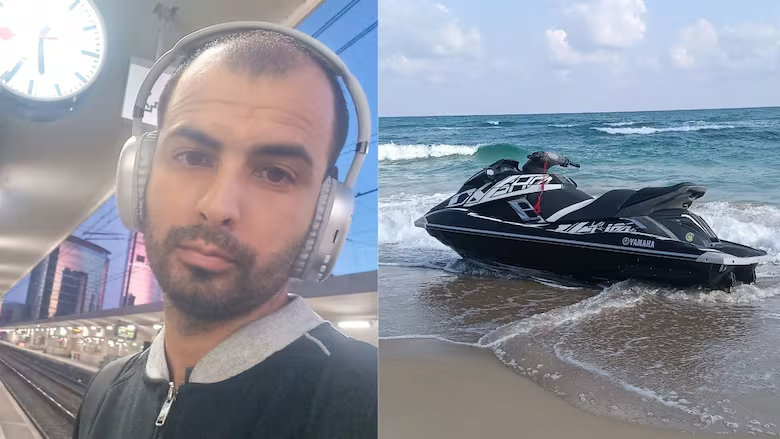By Siddhi Vinayak Misra
Copyright breezyscroll

Muhammad Abu Dakha, a 31-year-old Palestinian from Gaza, undertook a year-long, perilous journey to Europe that involved failed asylum attempts, brutal smuggling routes, and a final daring escape across the Mediterranean on a jet ski. His story highlights both the desperation driving migration and the extraordinary risks people take for survival.
Why one man risked everything to flee Gaza
For nearly two years, Gaza has been at the center of devastation caused by the Israel-Hamas conflict. According to Gaza health officials, more than 57,000 Palestinians have been killed, and countless others displaced.
For Muhammad Abu Dakha, once the owner of a small internet shop in Khan Younis, the war destroyed both his livelihood and his home. His family now lives in a tent camp, while he embarked on a desperate journey to Europe with one goal: to secure safety and eventually bring his wife and two young children—one of whom needs medical treatment for a neurological condition.
In his own words: “Without my family, life has no meaning. That’s why I risked my life on a jet ski.”
The long road out: from Gaza to Egypt, then Asia
Abu Dakha’s odyssey began in April 2024, when he crossed the Rafah border into Egypt after paying $5,000. His initial hope was asylum in China, a rare and ambitious choice compared to the traditional routes through Africa or the Middle East.
He traveled to China via Malaysia and Indonesia, even corresponding with the UN Refugee Agency in Beijing. But when asylum prospects fell apart, he returned to Egypt. The failure underscored a harsh truth: options for Palestinians fleeing Gaza are extremely limited.
Libya: the hub of perilous crossings
With China behind him, Abu Dakha headed for Libya, a country notorious as one of the most dangerous gateways to Europe. Human rights groups and UN reports have long documented how traffickers and militias exploit migrants there through torture, extortion, and forced labor.
Most migrants attempt to cross the Mediterranean in overcrowded, unsafe boats. Italy’s Interior Ministry data shows that more than 47,000 people had arrived this year alone, mainly from Libya and Tunisia.
But Abu Dakha’s path would be unlike any other.
Choosing the unthinkable: A jet ski
After ten failed attempts with smugglers, Abu Dakha decided to take matters into his own hands. He purchased a second-hand Yamaha jet ski for $5,000 through a Libyan online marketplace, adding $1,500 worth of survival gear:
GPS navigation system
Satellite phone
Life jackets
Extra supplies stored in a small inflatable dinghy
Joining him were two younger Palestinians, Diaa (27) and Bassem (23). Together, they mapped fuel requirements using ChatGPT, showing how digital tools have become unlikely companions in modern migration.
On August 18, 2025, they set out from al-Khoms, Libya. The journey was brutal—12 hours of navigating waves, avoiding a Tunisian patrol boat, and towing their dinghy. Eventually, they ran out of fuel just 20 kilometers shy of Italy’s Lampedusa island.
A distress call saved them. A Romanian patrol boat, part of the EU’s Frontex mission, rescued the trio, with officials later calling it “an unusual occurrence.”
Escape within Europe: from Sicily to Germany
Their arrival in Italy didn’t end the journey. Transferred first to Lampedusa’s migrant center, then to Sicily, they were eventually placed on a bus to Genoa. Before reaching the destination, they slipped away, hiding in the bushes for hours.
Abu Dakha then boarded a budget flight from Genoa to Brussels. From there, he took trains to Cologne and Osnabrueck in Germany, where a relative picked him up.
Today, he lives in a migrant reception center in Bramsche, Lower Saxony, awaiting an asylum decision. Germany’s migration authorities declined to comment on his individual case.
What makes this story unique?
Most stories of migration across the Mediterranean follow predictable, tragic patterns of overcrowded boats and mass drownings. Abu Dakha’s decision to attempt the crossing on a jet ski is both daring and symbolic:
Unconventional method: Few, if any, documented cases exist of Palestinians making the journey this way.
Costly gamble: He spent nearly $12,000 over a year—a staggering sum given Gaza’s poverty levels.
Digital reliance: From contacting UNHCR to using ChatGPT for fuel calculations, his journey reflects how modern technology intersects with ancient struggles for survival.
What does this reveal about migration pressures?
Abu Dakha’s story is more than an adventurous anecdote—it reflects the growing desperation among Palestinians and migrants worldwide:
Blocked legal pathways: With asylum avenues shrinking globally, irregular migration becomes the only option.
High human cost: Migrants face extortion, abuse, and death in Libya’s smuggling networks.
European dilemmas: Each unusual arrival highlights the EU’s struggle to balance humanitarian responsibility with border enforcement.
Experts say such stories will only increase as conflicts and climate change continue to displace populations.
The unfinished journey
While Abu Dakha now waits in Germany, his family remains in Gaza, living in tents amid ruins. His dream is not yet fulfilled: bringing his wife and children to safety.
For now, his jet ski crossing stands as one of the most unusual migration stories of the year—an act of desperation that underscores both resilience and the extreme risks displaced people are forced to take.



